Servicios Personalizados
Articulo
Indicadores
Links relacionados
-
 Citado por Google
Citado por Google -
 Similares en Google
Similares en Google
Compartir
Journal of the Southern African Institute of Mining and Metallurgy
versión On-line ISSN 2411-9717
versión impresa ISSN 2225-6253
J. S. Afr. Inst. Min. Metall. vol.122 no.11 Johannesburg nov. 2022
http://dx.doi.org/10.17159/2411-9717/1104/2022
PROFESSIONAL TECHNICAL AND SCIENTIFIC PAPERS
A new method for determining muckpile fragmentation formed by blasting
A. Tosun
Dokuz Eylul University, Department of Mining Engineering and Bergama Vocational School Buca-Begama-Izmir/Turkey
SYNOPSIS
Muckpile fragmentation formed by blasting depends on the specific charge factor, the discontinuities in the rock mass, and the rock strength. Determination of the discontinuity characteristics and rock strength is a long and difficult process. These two parameters are directly associated with the rock drilling speed. Therefore, it is the drilling speed of the machine used for the blast-hole, rather than the blasthole discontinuity characteristics and rock strength parameters, that is used in the prediction of muckpile fragmentation before blasting. Primarily, it has been suggested that the muckpile fragmentation values can be correctly determined by establishing correlations between the efficiency of the loader and muck pile fragmentation, since fragmentation is directly correlated with the former parameter. Subsequently, a correlation predicting the drilling speed of the drill machine was developed according to the discontinuity characteristics of the blasting surface and the rock strength. Finally, a correlation was developed predicting muckpile fragmentation according to the specific charge factor and the drilling speed of the drill machine The data was obtained by conducting blasting tests in two different limestone quarries.
Keywords: muckpile fragmentation, rock-drilling yield, specific charge factor.
Introduction
Muckpile fragmentation by blasting in open quarries determines the efficiency of the loading, transportation, and crushing processes that constitute the subsequent phases. Therefore, it is important to properly predict muckpile fragmentation before blasting. Many researchers have conducted studies related to the subject (Langefors and Kilhström, 1963; Bergmann, Riggie, and Wu, 1973; Rustan, 1981; Grady and Kipp, 1987; Persson,Holmberg, and Lee, 1994; Cunningham, 1983, 1987; Chung and Katsabanis, 2000). In all of these studies, the parameters determining the specific charge factor, rock strength, and blasting surface discontinuity characteristics were used.
While calculating the specific charge factor values in the blasting operations is easy, it is difficult to determine the rock strength and the blasting surface discontinuity characteristics in site conditions. The values of rock strength are determined by applying certain tests in a rock mechanics laboratory to samples from the site. However, the measurement of the discontinuity values using a measuring tape and compass can be a long and tiresome process.
The discontinuity characteristics of the blasting surfaces are found according to the method developed by Lilly, (1986). In this method, the vertical discontinuity interval and the discontinuity plane angle are defined as the discontinuity characteristics. The vertical discontinuity range is defined by the length of the blasting surface per fissure, while the discontinuity plane angle is the difference between the dip direction of the blasting surface and that of the crack surfaces. This difference determines whether the planar angle remains inside the surface or not.
There is a direct correlation between the rock drilling speed and the rock mass characteristics (the rock strength and discontinuity characteristics) (Hoseinie, Aghababaei, and Pourrahimian, 2008; Teale, 1965; Selim and Bruce, 1970; Wilbur et al., 1982; Howarth, Adamson, and Berndt, 1986; Jimeno Jimeno, and Carcedo, 1995; Kahraman, 1999).
Therefore, before blasting, the value of the blast-hole drilling speed can be used instead of the rock strength and the discontinuity characteristics of the blast-hole surface in the correlations predicting muckpile fragmentation. Thus, the effect of the rock strength and blasting surface discontinuity characteristics on fragmentation can be determined both faster and easier.
In this study, blasting tests were conducted in two limestone quarries. In all the tests, the rock strength, blasting surface discontinuity characteristics, speed of drilling, specific charge factor values, muckpile fragmentation, and efficiency of the loader were measured. Primarily, it was assumed that the muckpile fragmentation values could be determined correctly by establishing correlations between the efficiency of the loader and muckpile fragmentation. This relates to the fact that even if the loader is burdened by the increase of muckpile during loading, the loader operates more easily, and this is emphasized also by many researchers (Singh and Yalcin, 2002; Osanloo and Hekmat, 2005; Sari and Lever, 2007; Segarra et al., 2010). In addition, a correlation between the drilling speed, strength and blasting surface discontinuity characteristics was established. In the final phase, a correlation between the muckpile fragmentation due to blasting, the specific charge factor, and the drilling speed was determined.
Field and laboratory studies
Blast tests were conducted in two limestone quarries in Izmir, Turkey. Eighteen blasting tests in total were conducted: eight in the first quarry and 10 in the second. The locations of the sites are shown in Figure 1.

The discontinuity characteristics, speed of drilling the blast-holes, specific charge factor, size distribution of the muckpile, and oil pressure in the hydraulic pistons of the loader (which indicate the efficiency of the loader) were precisely measured. The density and uniaxial compressive strength of the rock of both limestone quarries were determined in the laboratory.
Discontinuity range of the blasting characteristics
The vertical discontinuity range of the blasting surfaces, and dip direction and angles of the joints, layering, and the blasting surfaces were Measured. A tape was used to measure the vertical discontinuity ranges, while a compass was used to determine the dips and dip directions. It was observed that the layering has more influence on the blasting surfaces than the joints. Therefore, the difference between the dip direction of the blasting surface and that of the stratification surfaces was calculated. The results are given in Table I.

Drilling speed
Blasting operations in both quarries were conducted by drilling blast-holes 89 mm in diameter. The total length of holes drilled for each blast test and the working hours of the driller were recorded. These values were averaged in a very precise manner by conducting observations until the end of the process in each test. The drilling speed was also obtained by dividing the total length of the holes by the working hours (Table II).

Specific charge factor
The weight of the fragmented material from each blast was measured using a weighbridge and the total material volume calculated using this value and the unit volumetric weight. The specific charge factor values were determined by dividing the total amount of explosive used by the total material volume (Table III). ANFO was used as the explosive in the blasting operations and nitroglycerin-based dynamite was used to trigger the ANFO.

Determination of muckpile fragmentation
The pile from each blast was divided into sections and photographs of the sections, separated in a manner representing the entire pile, were taken. The size distributions were determined by the image analysis using WipFrag programme. Finally, the size distribution values representing the entire pile were determined on average for all blasting tests by combining the size distribution values from each photograph. The size distribution values were determined for each blasting test using the new model developed in order to ensure that very fine fragments were used in the calculation (Tosun, 2018). The results are presented in Table IV. The size values related to the eighth blast test conducted in the second quarry could not be determined due to a data storage problem.
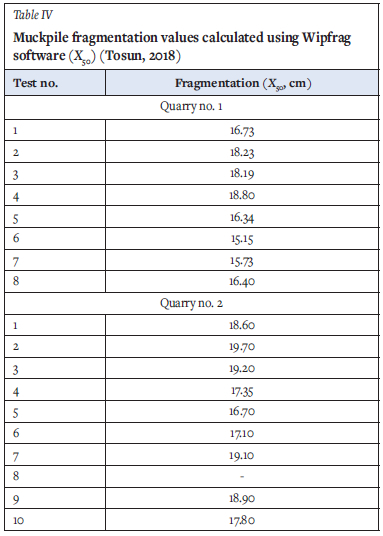
Hydraulic pressure in the loader
With increasing muckpile fragmentation, the forces on the loader will increase. The pressure in the hydraulic cylinders of the loader will vary according to the size distribution of the material during loading, and these variations indicate the efficiency of the loader. The pressure values were recorded using the image processing technique of (Tosun et al., 2012). This data could not be measured in the first test in the first quarry due to some field problems. The hydraulic pressure values were recorded until the entire pile had been loaded. The results are shown in Table V.
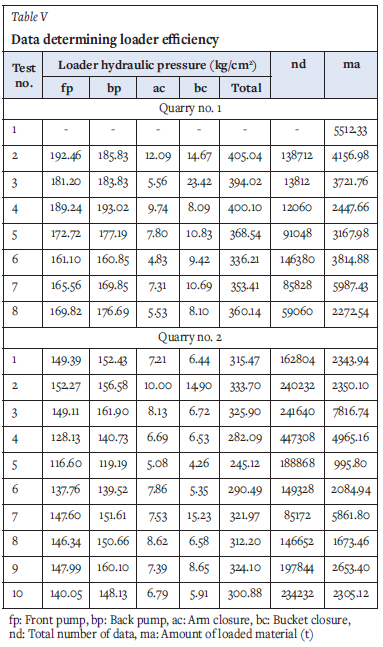
Laboratory studies
Uniaxial compressive strength tests were carried out on the core samples from the sites where the blasting tests were conducted. Unit volumetric weights of the core drilling samples were determined with a precision balance and digital calipers and their densities measured with a helium pycnometer. The results from the laboratory studies are given in Table VI. The table also shows the number of tests performed and the standard deviation values.
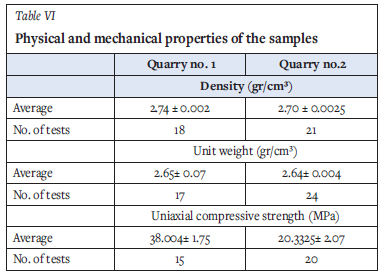
Assessment
A relationship, was established between the three pressure variations that occur in the hydraulic pistons of the loader during loading and the average size distribution of the pile (Table VII, Figures 2 and 3). Because the loading work is performed by different loaders, the relationships were established separately for each site.
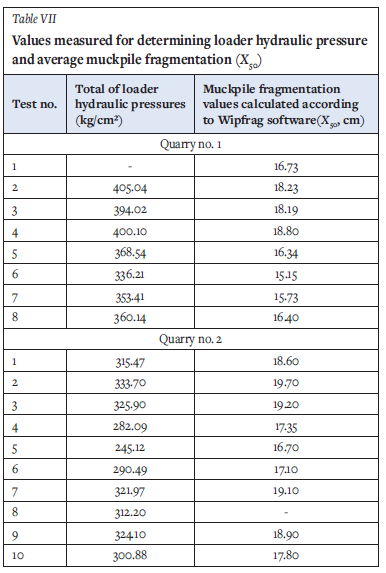
Figures 2 and 3, show strong relationships between total pressure values in the hydraulic pistons of the loader and the average size distribution of the pile. This indicates shows that the values of muckpile fragmentation that occurs because of blasting are determined correctly.
In the second part of the assessment, a correlation predicting the drilling speed values was developed by conducting a multiple regression analysis between the discontinuity values of the blasting surfaces and the uniaxial compressive strength values of the rock (Table VIII, Equation [1]). The discontinuity characteristics of the blasting surfaces, the vertical discontinuity range, the blasting surface, and the difference in slope direction angle between the layers were used. It was determined that the layers are denser on all blasting surfaces compared to the joints.
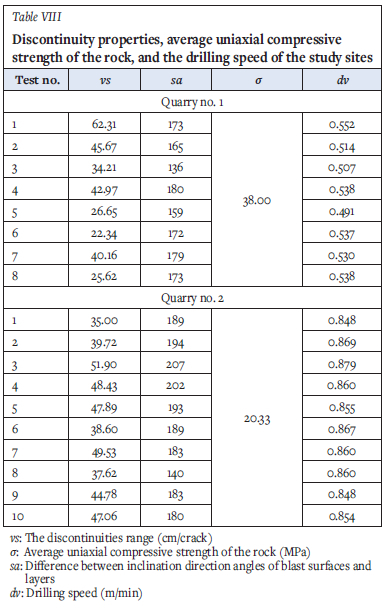

dv = Drilling speed of the drilling machine (m/minute)
vs = Vertical discontinuities range (cm/crack)
sa = Difference between inclination direction angles of
blast surfaces and layers
σ = Average uniaxial compressive strength of the rock (MPa).
Drilling speeds were measured and calculated according to Equation [I]; the percentage errors are given in Table IX. The proximity of the said data-sets to each other is shown in Figure 4. The slope of the linear vector in this case is 45°.
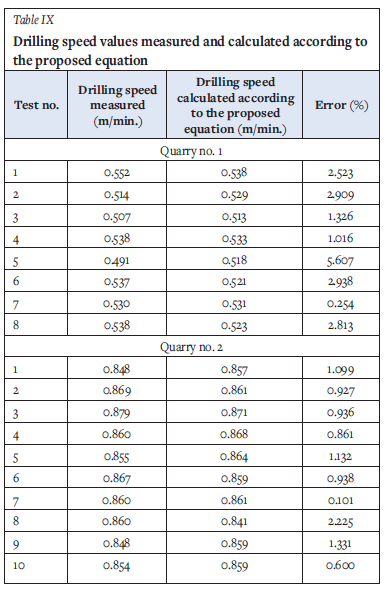

As understood from Table IX and Figure 4, very small errors were determined between the drilling speed values measured and those that were calculated according to Equation [1]. This shows that the drilling speed parameter is directly associated with the discontinuity characteristics of the blasting surfaces and the uniaxial compressive strength values of the rock.
In the last phase of the assessment, a correlation predicting the average size distribution value of the pile was determined using the drilling speed and the specific charge factor (Table X and Equation [2]).
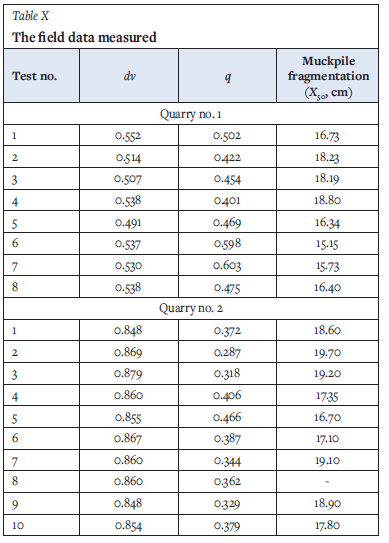

X50 : Muckpile fragmentation (cm)
dv : The drilling speed of the drilling machine (m/minute)
q : Specific charge factor (kg/m3)
The measured and calculated values of the average size distribution of the pile according to Equation [2] and the percentage errors between them are given in Table XI. The proximity of the data-sets to each other is shown in Figure 5. The slope of the linear vector in this case is 45°.
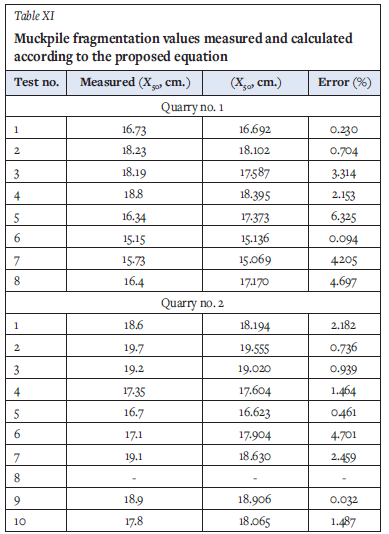
As understood from Table XI and Figure 5, very small errors were determined between the measured values of the average size distribution of the pile and those calculated according to Equation [2]. This condition shows that the average size distribution values of the pile are directly associated with the drilling speed and the specific charge factor.
In this study, the drilling speed values were used to determine the average size distribution after blasting rather than the discontinuity characteristics of the blasting surfaces and the uniaxial compressive strength of the rock. As is known from the literature, the determination of the discontinuity characteristics of the blasting surfaces is both difficult and time-consuming. Therefore, the correlations predicting the size distribution may give wrong results. This study tried to eliminate the misprediction of muckpile fragmentation.
The drilling speed values were measured as the values close to each other in the tests performed. It is important to carry out the study with rock and field characteristics that are different from each other.
Conclusion
In this study, 18 blasting tests in total were conducted: 8 tests in the first limestone quarry and 10 in the second limestone quarry. The rock strength, blasting surface discontinuity characteristics, speed values of the blast-hole driller, specific charge factor values, muckpile fragmentation, and efficiency of the loader were measured.
Primarily, for ascertaining whether the muckpile fragmentation values are determined correctly, correlations were established between the efficiency of the loader and muckpile fragmentation separately for both work sites since the material loading was conducted in both quarries by loaders of different characteristics. The correlation was determined to be 95.24 for the first and 87.69 for the second limestone quarry.
A correlation predicting the drilling speed of the driller according to the rock strength and the blasting surface discontinuity characteristics was then established. It was shown that the correlation obtained gave correct results with a value of 99.46%.
In the final phase, a correlation determining muckpile fragmentation due to blasting according to the specific charge factor and the drilling speed was established. It was shown that this correlation has given realistic results on a scale of 86.42%.
References
Bergmann, O.R., Riggle, J.W., and Wu, F.C. 1973. Model rock blasting - Effect of explosives properties and other variables on blasting results. International Journal of Rock Mechanics and Mining Sciences, vol. 10. pp. 585-612. [ Links ]
Chung, S.H. and Katsabanis, P.D. 2000. Fragmentation prediction using improved engineering formulas. International Journal of Fragmentation by Blasting, vol. 4. pp. 198-207. [ Links ]
Cunningham, C.V.B. 1983. The Kuz-Ram model for prediction of fragmentation from blasting. Proceedings of the First International on Rock Fragmentation by Blasting. pp. 439-453. [ Links ]
Cunningham, C.V.B. 1987. Fragmentation estimations and the Kuz-Ram model -four years on. Proceedings of the Second International on Rock Fragmentation by Blasting. Society for Experimental Mechanics, Bethel, CT. pp. 475-487. [ Links ]
Grady, D.E. and Kipp, M.E. 1987. Dynamic rock fragmentation. Fracture Mechanics of Rock. Academic Press, London, Atkinson, B.K. (ed). pp. 429-475. [ Links ]
Höseinie, S.H., Aghababaei, H., and Pourrahimian, Y. 2008. Development of a new classification system for assessing of rock mass drillability index (RDi). International Journal of Rock Mechanics and Mining Sciences, vol. 45. 110 p. [ Links ]
Howarth, D.F., Adamson, W.R., and Berndt, J.R. 1986. Correlation of modeltunnel boring and drilling machine performances with rock properties. International Journal of Rock Mechanics and Mining Sciences, vol. 23. pp. 171-175. [ Links ]
Jimeno, C.L., Jimeno, E.L, and Carcedo, F.J.A. 1995. Drilling and Blasting of Rocks. Balkema, Rotterdam. [ Links ]
Kahraman, S. 1999. Rotary and percussive drilling prediction using regression analysis. Journal of Rock Mechanics and Mining Sciences, vol. 36. pp. 981-989. [ Links ]
Langefors, U. and Kihlström, B. 1963. The modern Technique of Rock Blasting. Almqvist and Wicksell, Uppsala, Sweden. [ Links ]
Osanloo, M. and Hekmat, A. 2005. Prediction of shovel productivity in the Gol-E-Gohar mine. Journal of Mining Science, vol. 41, no 2. pp. 177-184. [ Links ]
Persson, P.A., Holmberg, R., and Lee J. 1994. Rock Blasting and Explosives Engineering. CRC Press, Boca Raton, FL. [ Links ]
Rustan, A. 1981. Fragmentation influencing factors in rock blasting. Technical rapport, Lulea University of Technology, Lulea, Sweden. 38T. [ Links ]
Sari, M. and Lever, P.J.A. 2007. Effect of blasted rock particle size on excavation machine loading performance. Proceedings of the 20th Intenational Mining Congress and Exhibition of Turkey. [ Links ]
Segarra, P., Sanchidrián, J.A., López, L.M., and Querol, E. 2010. On the prediction of mucking rates in metal ore blasting. Journal of Mining Science, vol. 46, no. 2. pp. 167-176 [ Links ]
Selim, A.A. and Bruce, W.E. 1970. Prediction of penetration rate for percussive drilling. Report of Investigations. 7396. US Bureau of Mines [ Links ]
Singh, S.P. and Yalcin, T. 2002. Effects of muck size distribution on scooping operations. Proceedings of the 28th Annual Conference on Explosives and Blasting Techniques. International Society of Explosives Engineers. pp 315-325. [ Links ]
Teale, R. 1965. The concept of specific energy in rock drilling. International Journal of Rock Mechanics and Mining Sciences, vol. 2. pp. 57-71. [ Links ]
Tosun, A., Konak, G., Karaku§, D., and Onur, A.H. 2012. Determination of loader efficiency with hydraulic pressure values. Proceedings of the International Multidisciplinary Scientific GeoConference SGEM, Bulgaria. pp. 531-538. [ Links ]
Tosun, A. 2018. A modified Wipfrag programme for determining muckpile fragmentation. Journal of the Southern African Institute of Mining and Metallurgy, vol. 118. pp. 1113-1119. [ Links ]
Wilbur, L., Kuesel, T.R, King, E.H., and Bickel, J.O. 1982. Tunnel Engineering Handbook. Springs, New York. [ Links ]
 Correspondence:
Correspondence:
A. Tosun
Email: abdurrahman.tosun@deu.edu.tr
Received: 1 Feb. 2020
Revised: 21 Apr. 2022
Accepted: 15 Aug. 2022
Published: November 2022














